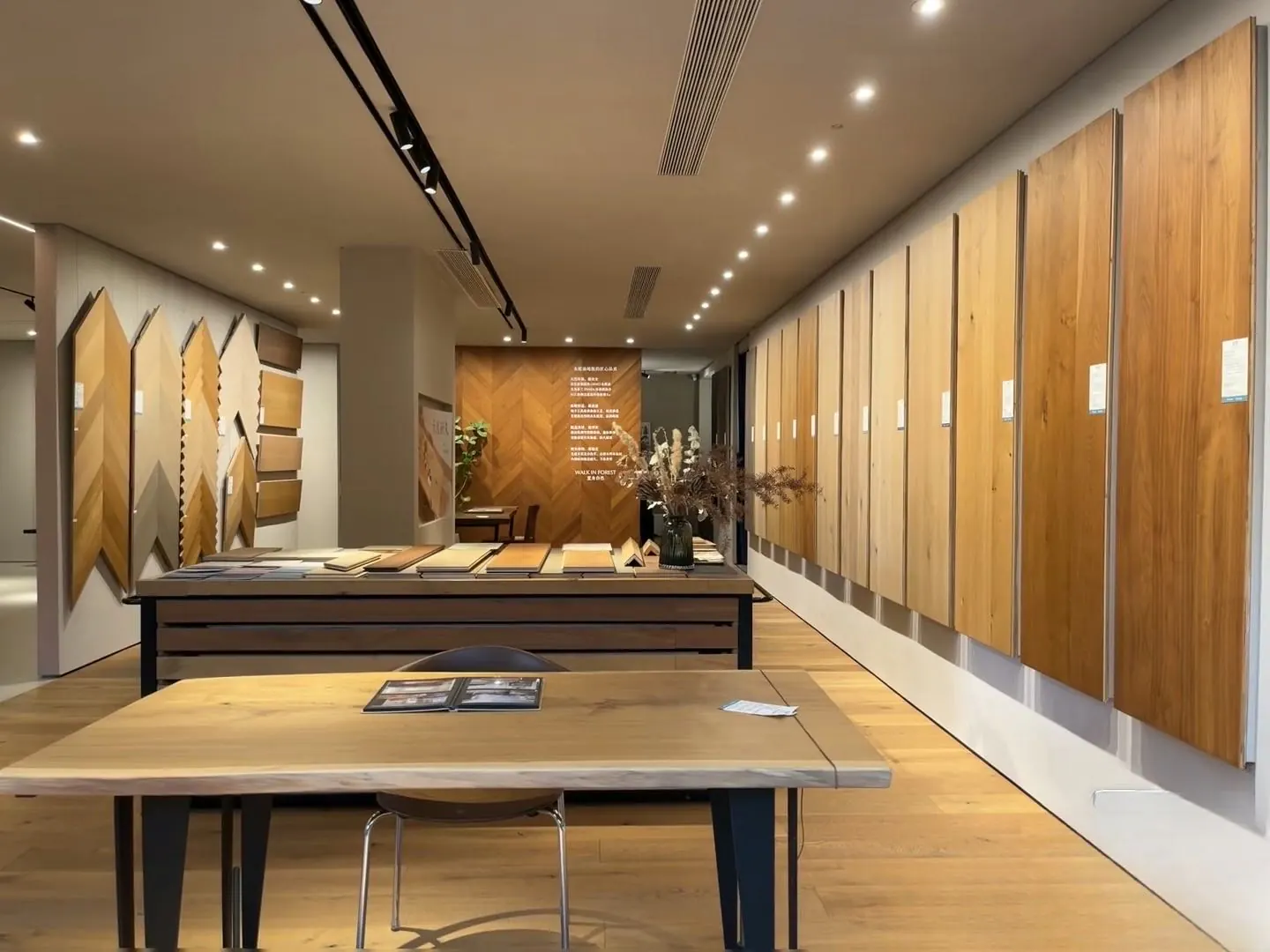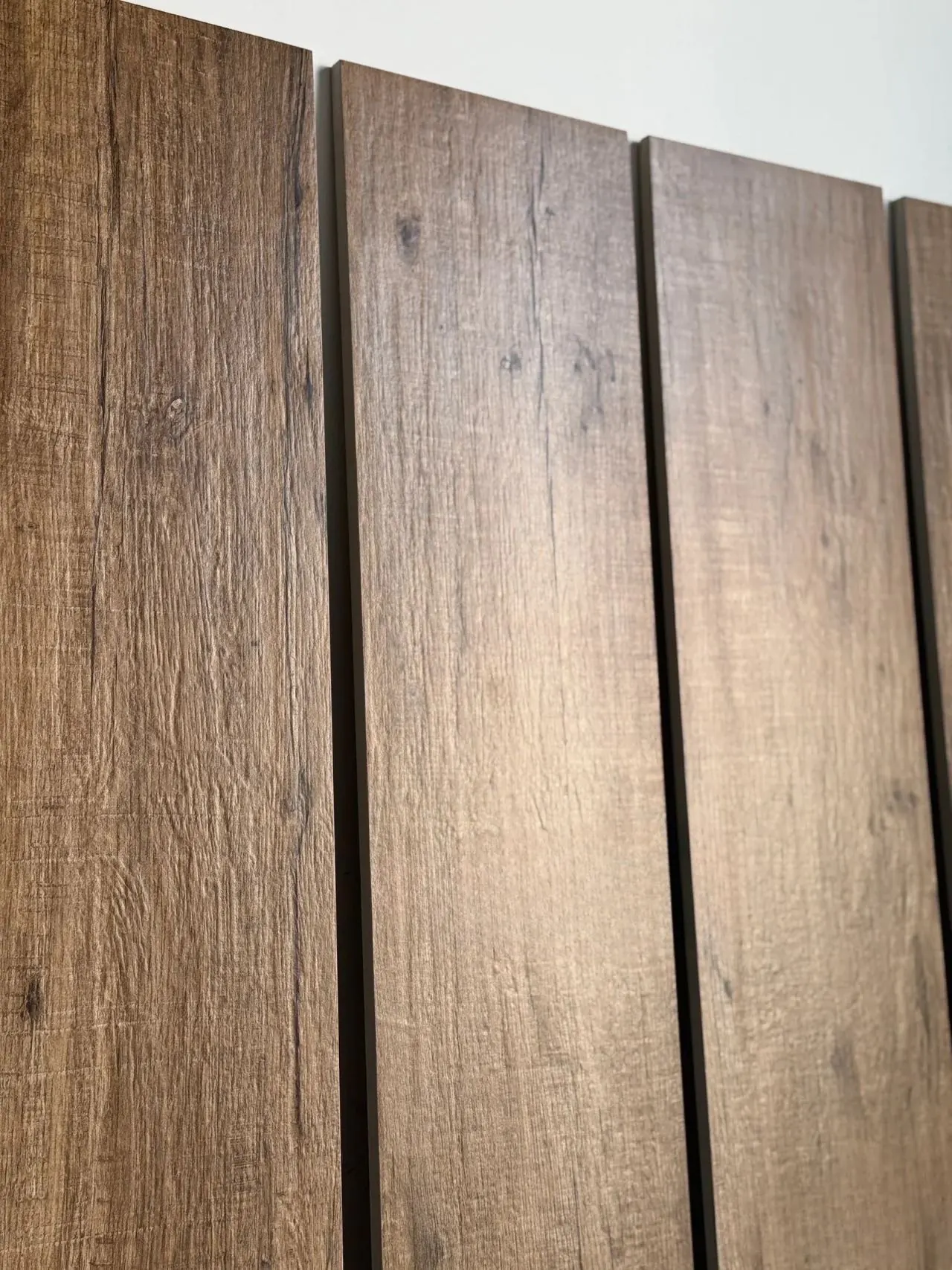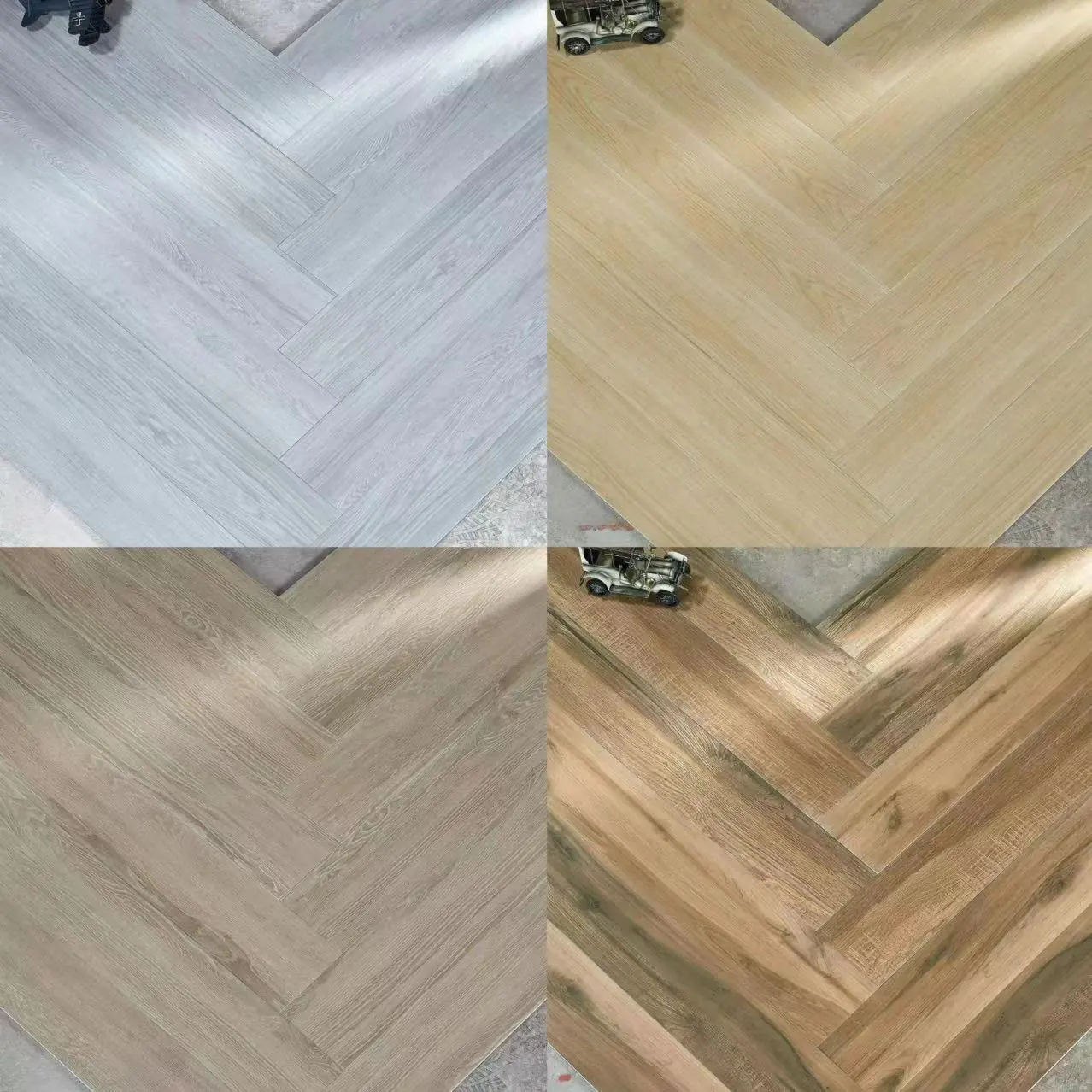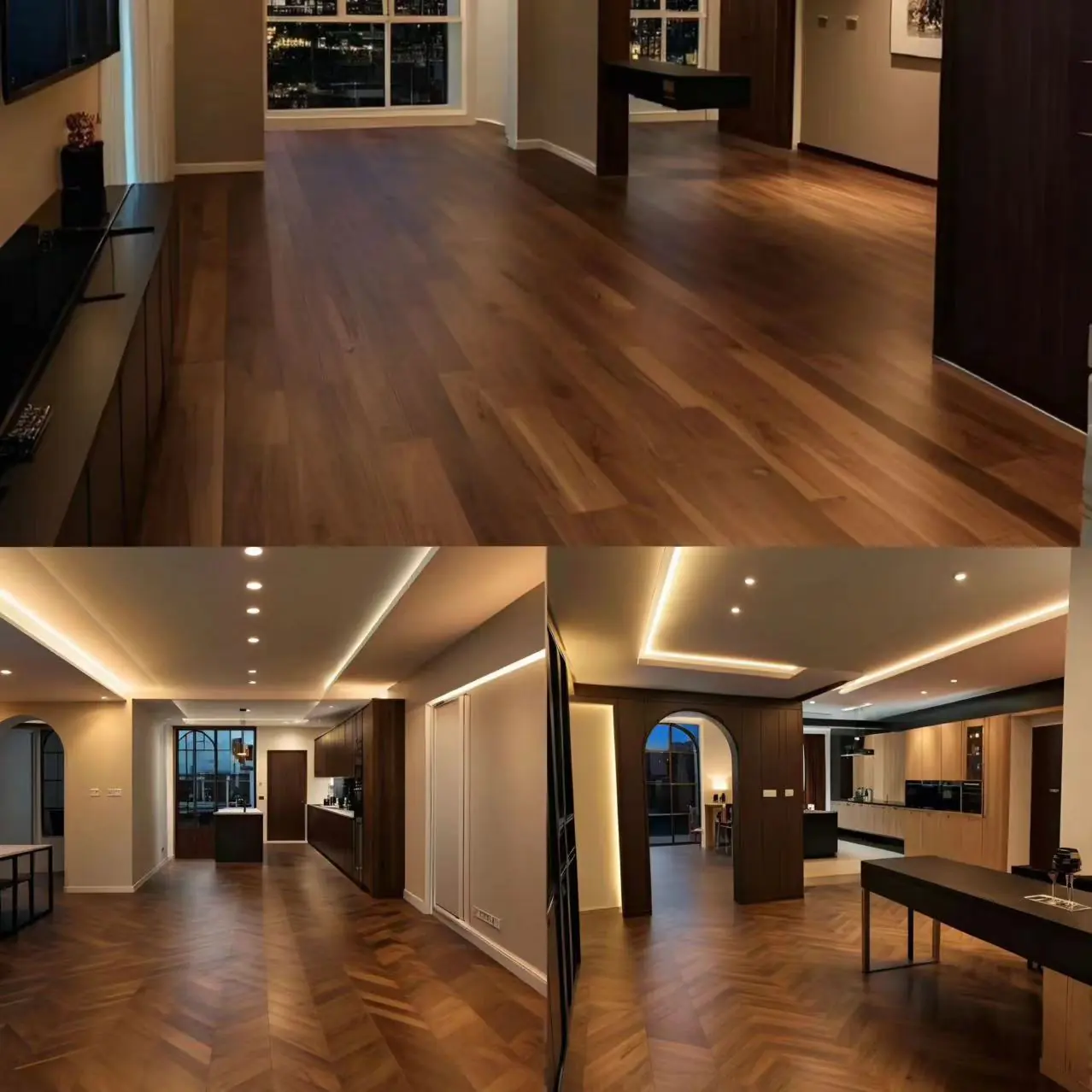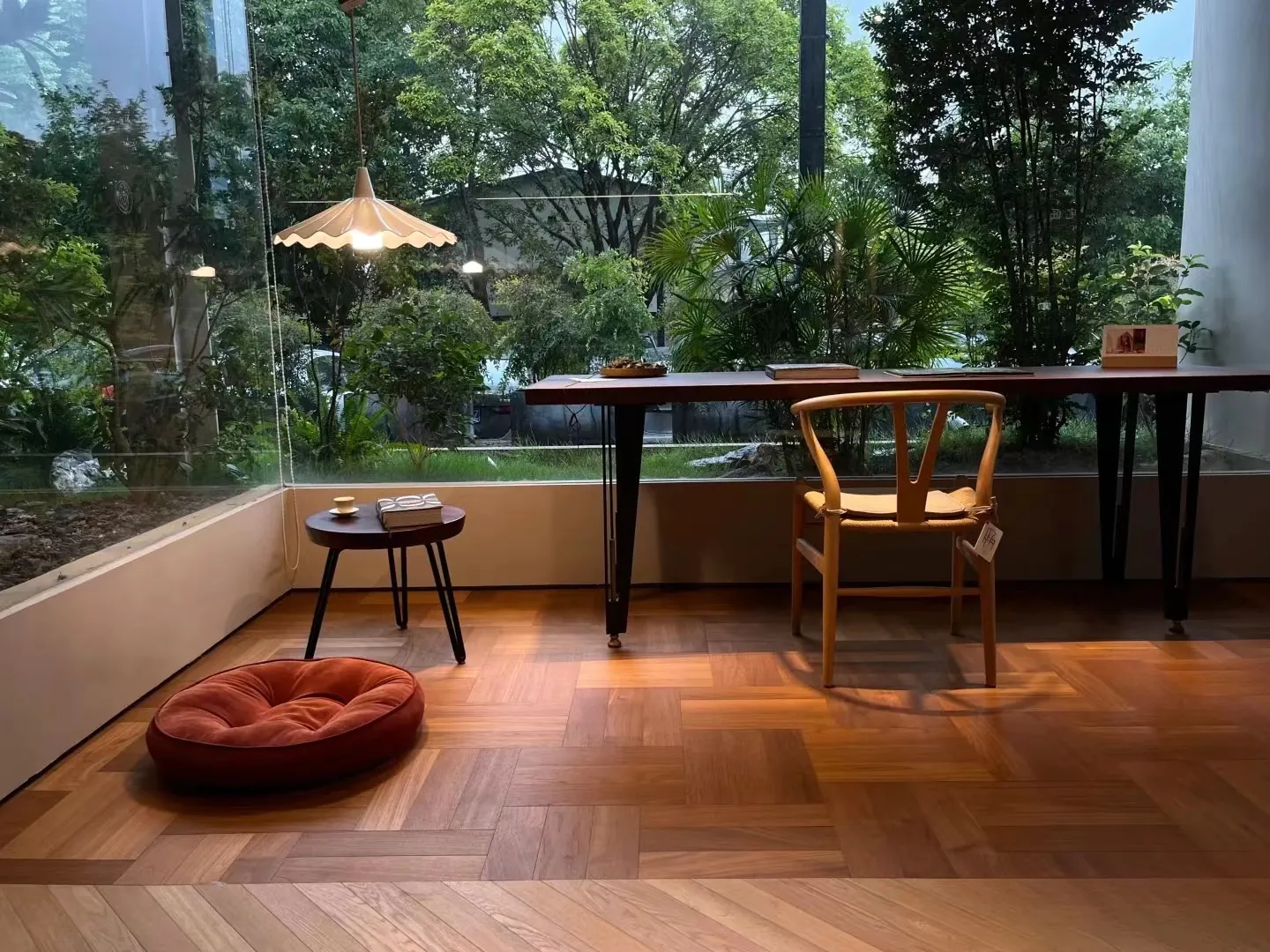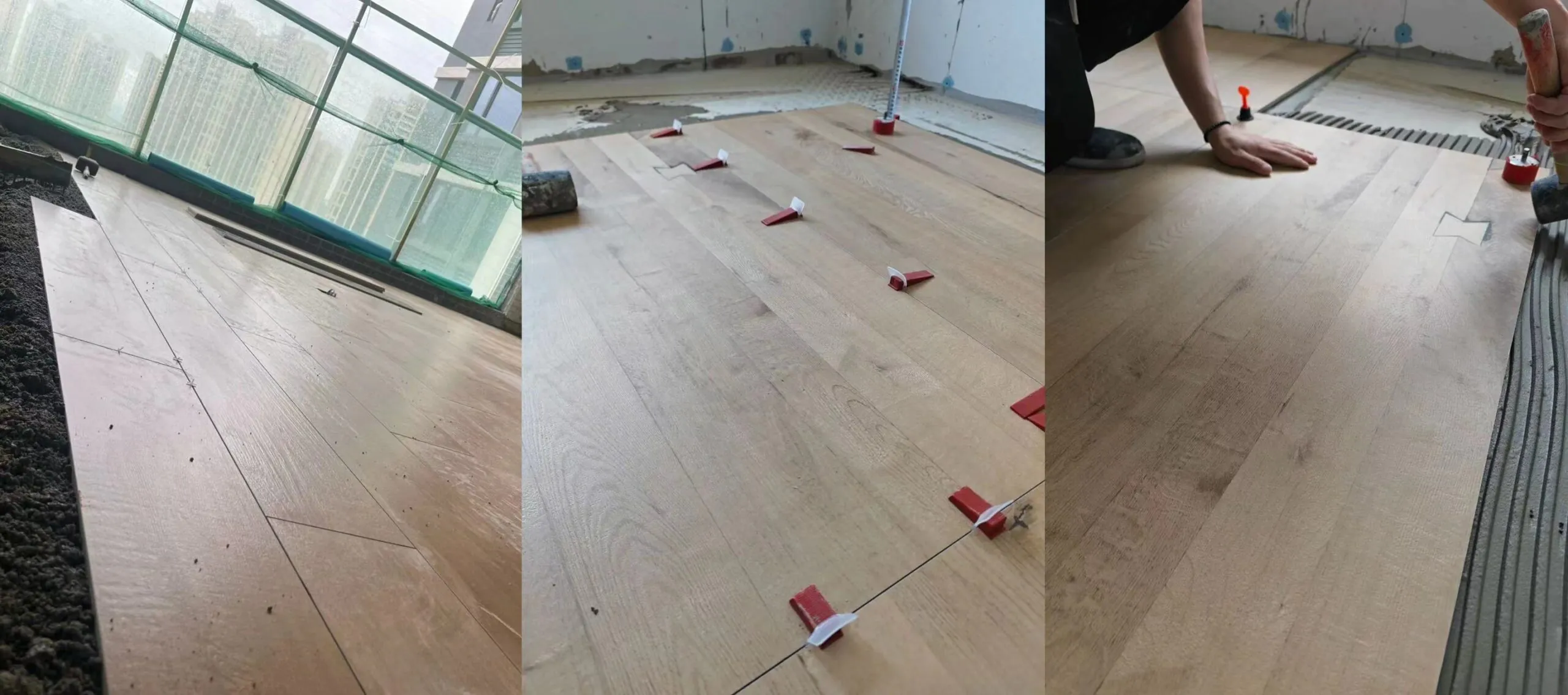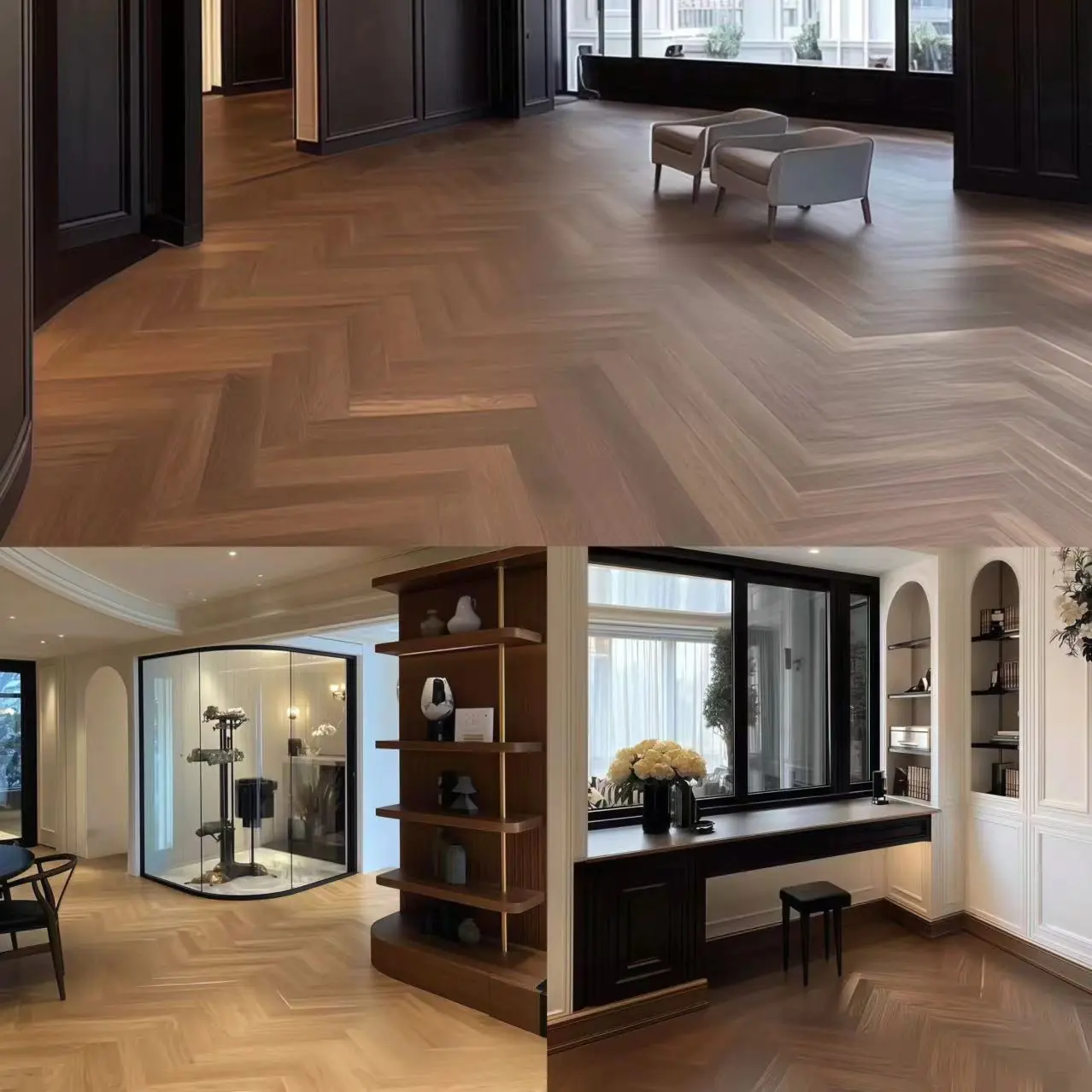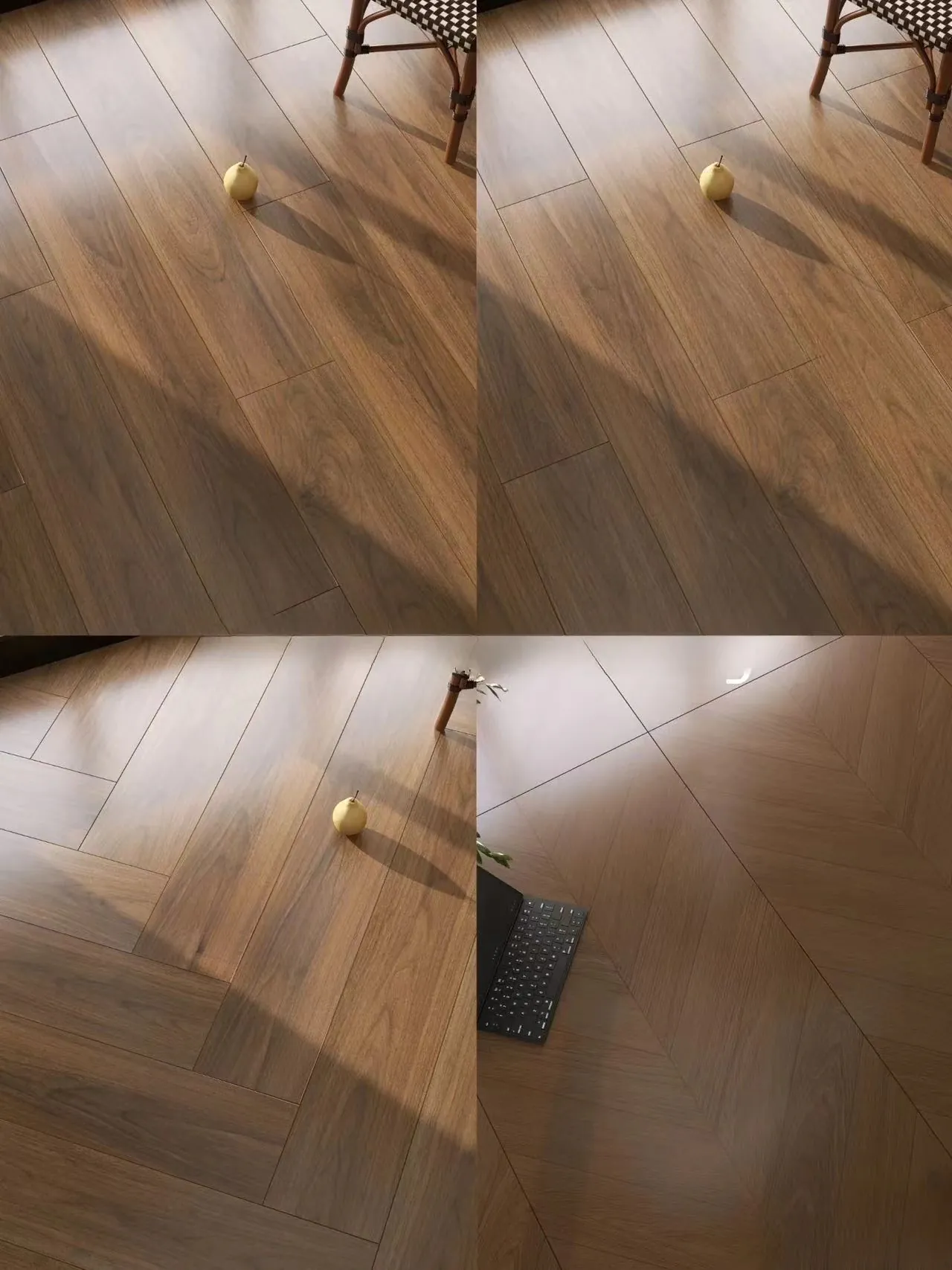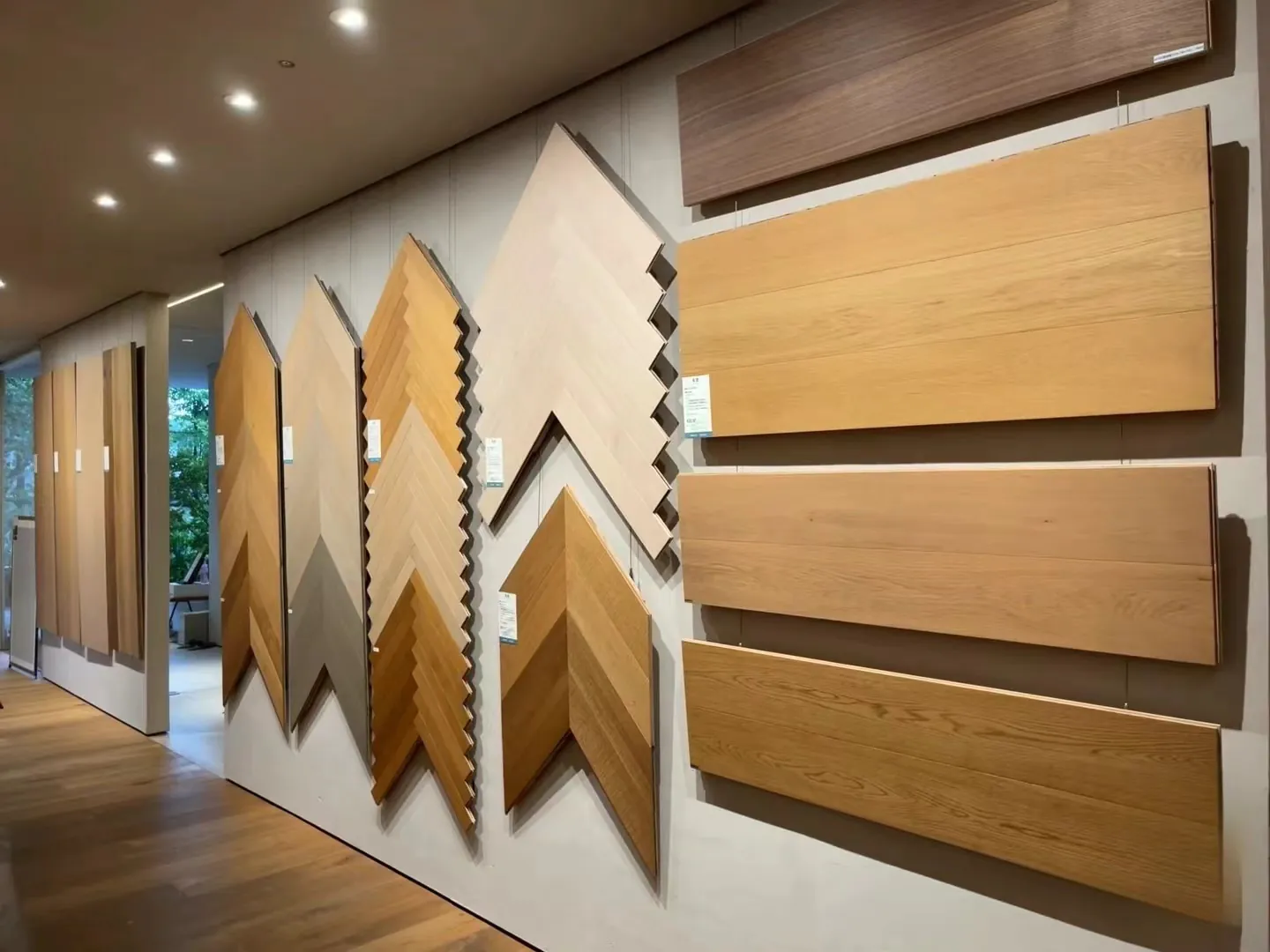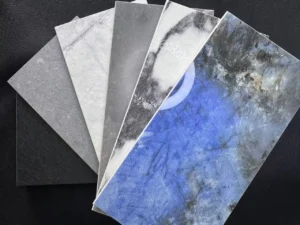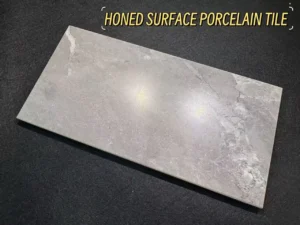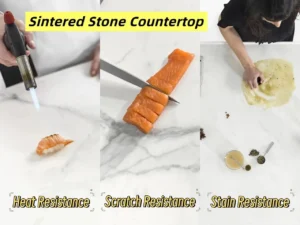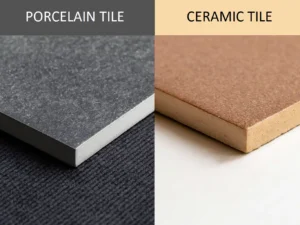Wood-look tile flooring has surged in popularity as a way to enjoy the warm, natural beauty of wood with the durability and easy upkeep of tile. In fact, China is one of the leading producers of wood-look ceramic and porcelain tiles, supplying high-quality wood tile flooring1 to projects worldwide. Whether you’re renovating a home or specifying materials for a commercial build, wood-effect tiles from Chinese manufacturers (especially those in Foshan, the country’s ceramic tile hub) offer an attractive blend of style, strength, and cost-effectiveness. This article will explore exactly what wood-look tile is, the key benefits it offers, typical costs (and how they compare to real hardwood), and how long you can expect a wood-look tiled floor to last.
What is wood-look tile?
Wood-look tile (often simply called “wood tile”) is a manufactured flooring tile—usually made of porcelain or ceramic—that is designed to mimic the appearance of natural hardwood. Advanced digital inkjet printing and molding techniques are used to infuse tiles with highly realistic wood grain patterns, colors, and even textures. This means at a glance, individual planks of wood-look tile can look almost indistinguishable from real wood planks. The tiles are typically produced in long rectangular shapes (like 150×900 mm or 200×1200 mm planks) to mirror the dimensions of hardwood flooring boards.
Unlike actual wood, which is organic and porous, wood-look tiles are made from fired clay (ceramic or porcelain) and glazed. Porcelain is the denser, less porous option—absorbing <0.5% of water—making it ideal for high-moisture areas (bathrooms, kitchens) and even outdoor patios. Ceramic wood-look tiles are also water-resistant (thanks to protective glazing), though generally a bit more porous than porcelain, so they’re often recommended for drier or lower-traffic areas. Both types, however, will not warp or swell from humidity the way real wood does. They’re engineered to be tough: the surface glaze protects the printed design and provides a hard wear layer.
In summary, wood-look tile flooring gives you the aesthetic of hardwood (from rustic oak to sleek maple or any species/finish you like) on a tile’s body. The result is a floor that offers the warmth and style of wood paired with the superior durability and eco-friendly benefits2 of tile. Because it’s still a ceramic/porcelain product, wood tile is inherently fire-resistant, doesn’t attract termites or mold, and won’t fade under UV light. It can be used in heavy-traffic indoor areas like living rooms, hallways, and entryways, and even carried into wet areas such as kitchens, baths, laundry rooms, and mudrooms where real wood would normally be at risk. Some wood-look tiles are rated for outdoor use as well (if they have a slip-resistant3 texture). Overall, this flooring option is a versatile fusion of natural beauty and industrial strength.
What are the benefits of wood tile?
Wood-look tile comes with a long list of benefits, combining the best aspects of hardwood and traditional tile. Here are some of the key advantages of choosing wood tile flooring for your space:
-
Authentic Appearance: Thanks to today’s high-definition printing and glazing technologies, wood-effect tiles capture the realistic grain patterns, color variations, and even knots of real wood. From rich walnut or oak tones to whitewashed or weathered gray looks, the design options are virtually endless. Many people have to look closely (and even touch the surface) to tell it’s not actual wood! This allows you to achieve nearly any wood style or trend with tile. Plus, tiles can be arranged in all the classic patterns—straight planks, staggered (running bond), herringbone, chevron, etc.—for a genuine wood-floor look.
-
Water & Moisture Resistance: One of the biggest selling points of wood-look tile is that it’s completely water-resistant4. You can use it in moisture-prone areas like bathrooms, kitchens, basements or mudrooms without worry, since the tile won’t warp, swell, or discolor from water exposure the way natural wood can. Spills or wet footprints aren’t a problem at all. This makes wood tile an excellent choice for achieving a hardwood look in places where real wood isn’t advisable. Even outdoors, certain porcelain wood tiles can be used for patios or pool decks (they won’t be damaged by rain or temperature changes).
-
Extreme Durability: Porcelain and ceramic tiles are incredibly hard and wear-resistant, so wood-look tile flooring can stand up to heavy foot traffic, pet claws, and daily wear far better than hardwood. Scratches, dents, or dings are rare on a quality porcelain wood tile. You also won’t get the fading or sun-bleaching that often plagues hardwood floors over time. Heavy furniture won’t leave dents (no more worrying about couch or table leg indentations). In short, wood-look tile offers the hard-wearing, scratch-proof resilience of tile with the look of wood. This makes it especially great for busy households with kids, pets, or lots of guests, as well as high-traffic commercial environments.
-
Low Maintenance: Wood-look tile floors are about as easy to maintain as it gets. Unlike real wood which may require periodic refinishing, sealing, or special cleaners, wood tile needs no such intensive care. There’s no need to ever sand or re-stain the floor, since the tile’s finish is permanent and doesn’t dull like wood finish can. Routine maintenance is simply sweeping or vacuuming as needed and the occasional damp mop with a mild cleaner. The tile’s glaze prevents stains from penetrating, and you won’t have issues like scratches that need refinishing. No polishing, waxing or resurfacing is required to keep it looking like new. This low upkeep saves both time and money over the lifetime of the floor.
-
Fire & Pest Proof: Because it’s a ceramic-based product, wood-look tile is non-combustible – it won’t burn or emit toxic fumes in a fire (whereas hardwood is flammable). This can be a safety advantage. Additionally, tiles are inorganic, so you’ll never face termite damage or wood rot. In humid climates, you also avoid mold or mildew issues that can sometimes affect wood. Wood tiles are a very stable and inert material for long-term use in a home.
-
Cost-Effective: Wood-look tile is often more affordable than genuine hardwood flooring, especially for similar looks in high-end species or exotic woods. As one expert notes, “Hardwood floors can cost up to \$15 per square foot while tile can range from \$1.50–\$5 per square foot.” The initial material cost for wood tile tends to be lower than for solid hardwood or even good quality laminate. And when you factor in the longevity and minimal maintenance (no costly refinishing jobs, no replacement of water-damaged boards, etc.), the long-term cost of ownership is even more economical. We’ll dive deeper into pricing in the next section, but suffice to say, wood tiles deliver a luxury look for a fraction of the price in many cases.
-
Design Versatility: With wood-look tile, you get the design versatility of tile formats combined with the visual appeal of wood. Tiles come in various plank lengths and widths, allowing you to choose a format that suits your design (modern large-format planks, classic narrower strips, or even multi-width layouts). You can also find wood tiles in different surface finishes—matte, textured, hand-scraped effect, etc.—to match the exact wood style you love, whether that’s a smooth contemporary finish or a rustic reclaimed-wood vibe. Color and style options are abundant, from golden oak to gray driftwood to espresso brown, and new collections continue to follow interior design trends. This means you can integrate wood-look tile with any decor theme, and use it throughout an open floor plan (even in kitchens and baths) for a seamless, coordinated look.
-
Eco-Friendly Aspects: Opting for wood-look tile can also be considered environmentally friendly compared to using real timber. Every square foot of ceramic tile installed is a square foot of wood saved from harvesting. High-quality tiles last for decades, reducing waste from replacing worn-out floors. Additionally, many porcelain tiles are made from natural clay and minerals and can have recycled content, whereas removing old hardwood often isn’t as recyclable. Thanks to its durability and inert nature, tile has a very long usable life (often beyond 20+ years) which means less frequent replacement and less material consumption over time. If you love the look of wood but want to “go green”, wood-effect tile is a smart choice.
In summary, wood tile flooring delivers the beauty of wood with none of the downsides of the natural material. You get a floor that’s waterproof, tough, easy to clean, and cost-effective, all while looking stunningly similar to real wood. These benefits explain why homeowners and designers are increasingly turning to wood-look porcelain and ceramic tiles as a superior alternative to traditional hardwood floors.
Is wood tile expensive?
One common question is how the cost of wood-look tile compares to other flooring, especially real hardwood. The good news is that wood tile is generally quite affordable, particularly when you consider its long-term value. Let’s break down the cost factors:
-
Material Cost (Tile vs. Hardwood): In terms of just buying the flooring material, wood-look ceramic or porcelain tile often costs significantly less than solid hardwood flooring of comparable style/quality. For example, porcelain wood tile might retail around \$2–\$5 per square foot (approximately \$20–\$54 per square meter) for many styles, whereas real hardwood planks can cost anywhere from \$5–\$15+ per square foot depending on the wood species. Even engineered hardwood or high-end laminate tends to be pricier than common wood-look tile. The budget advantage goes to wood tile upfront. It’s possible to get an upscale wood design in tile form without paying for exotic wood material. In markets like North America or Europe, good quality wood-look porcelain tiles might be, say, \$4 per sq.ft., whereas an oak or walnut floor could be double that.
-
Wholesale/Factory Pricing: If you are sourcing wood-look tiles directly from China (for large projects or distribution), the cost can be even more economical. Chinese tile manufacturers offer very competitive FOB prices. For instance, a supplier in Foshan might quote wood-look tiles in the following range (bulk order, FOB Foshan port):
- 150×900 mm planks: Ceramic ≈ \$4.70 per m², Porcelain ≈ \$5.90 per m²
- 200×1000 mm planks: Ceramic ≈ \$4.95 per m², Porcelain ≈ \$6.40 per m²
- 200×1200 mm planks: Ceramic ≈ \$5.45 per m², Porcelain ≈ \$6.90 per m²
(Prices above are approximate, for reference, and based on FOB Foshan export terms in 2025. Actual quotes may vary by supplier and order size.)
To put that in perspective, \$5–\$7 per square meter is only about \$0.50–\$0.65 per square foot – a remarkably low cost for flooring. Even with shipping and import fees added, the per-square-foot cost of imported wood-look tile can come out far lower than domestic retail pricing for similar products. This is a big reason why many contractors and importers look to China for supply: you can get high-quality porcelain wood tiles at a fraction of the cost, especially if buying in volume.
-
Porcelain vs. Ceramic (Cost Difference): You might notice from the above that porcelain tiles are a bit more expensive than ceramic. This is generally true: porcelain’s higher density and performance (near-zero water absorption, higher strength) make it cost slightly more to produce. For example, a given wood-look design might be \$1–\$2 more per square meter in porcelain than in a ceramic version. Even so, porcelain tile prices are still quite reasonable, and many buyers prefer porcelain for floor use due to its durability (especially in wet or heavy-use areas). Ceramic wood tiles can offer cost savings if budget is very tight or for wall/light-duty applications, but for most flooring projects the extra investment in porcelain is worth it for the longevity.
-
Installation Cost: When it comes to installation, tiling is a labor-intensive process, and skilled labor is required to properly lay wood-look tiles (especially large planks) with even subfloors and narrow grout lines. Therefore, the installation cost for wood tile flooring can be higher than for installing click-lock laminate or even hardwood boards. On average, professional tile installation might run \$5–\$15 per sq.ft. (including materials like mortar and grout). In contrast, hardwood installation might be \$4–\$8 per sq.ft. So you could spend a bit more on labor for the tile. As one flooring source notes: “Wood and tile are competitively priced [in material], but wood is more expensive to install, and the real cost-savings with tile is due to its longevity and durability.”. In other words, you might pay somewhat more upfront to have the tile installed, but you recoup that investment over time because the tile won’t need the upkeep that hardwood does. It’s also worth mentioning that larger tile planks (like 1200 mm long) may cost more to install than smaller ones, since they require extra care for leveling to avoid lippage (uneven edges). Using an experienced installer is highly recommended to ensure a beautiful result. Once in place, though, a tiled floor will likely never need to be replaced due to wear, whereas even a well-maintained wood floor might need refinishing or replacement after many years.
- Long-Term Value: The lifespan and minimal maintenance of wood-look tile contribute to its cost effectiveness. A hardwood floor might last decades too, but only if you periodically spend money to sand and refinish it, and you must be vigilant about water damage, scratches, etc. By contrast, a porcelain tile floor can easily last 20–50 years without major work (more on lifespan in the next section). The grout might need cleaning or resealing over time, but the tiles themselves will remain intact and looking good. This means no costly refinishing or replacement cycles. So, while the initial cost of wood tile is already usually lower than hardwood, its total cost of ownership is even better. Many homeowners find that choosing wood-look tile ends up saving them money in the long run.
In summary, wood tile flooring is not expensive when viewed in context. In fact, it’s often a budget-friendly way to achieve a high-end wood look. You can spend a little or a lot depending on the specific product (there are premium designer tiles as well), but broadly speaking, wood-look tile gives you more bang for your buck than real wood. If you love the look of hardwood but are concerned about cost, wood tile is a savvy solution that “offers savings over time” due to its durability. By sourcing from a reputable supplier (such as a manufacturer in China) and using professional installers, you can get a gorgeous wood-look floor that stays within budget and lasts for years to come.
How long does wood look tile last?
When investing in a new floor, longevity is a crucial consideration. One of the strongest arguments for wood-look tile is its exceptional lifespan. Simply put, a properly installed porcelain wood tile floor can last for decades – often far longer than a comparable hardwood floor would under the same conditions.
Typical Lifespan: Most ceramic and porcelain tile floors are known to have a life expectancy of 20 years or more with proper care. In fact, tile is one of the longest-lasting flooring materials available. With wood-look tiles, you can realistically expect multiple decades of service. Some flooring experts note that with proper installation, wood-look porcelain tile can last 50 years or more without significant deterioration. That means if you install a wood tile floor today, it could still be looking great half a century from now – truly a “lifetime floor” in many cases.
There are a few reasons wood-look tile lasts so long:
-
Resistance to Wear: As mentioned earlier, the surface of these tiles is extremely hard and resistant to scratches, dents, and stains. Even in high-traffic areas or homes with pets and kids, the tiles hold up well. They don’t get gouges or wear patterns like wood can. And unlike some cheaper flooring alternatives (e.g. vinyl planks that might scratch or dull over time), the glaze on a quality porcelain tile is very wear-resistant. This durability means the floor’s appearance ages very slowly.
-
No Fading or Aging: Wood-look tiles maintain their original color and pattern for their entire life. They will not fade or discolor from sunlight or UV exposure. Hardwood, on the other hand, often changes color (yellowing or darkening) or fades in sun-exposed areas. Tile’s inert pigments keep the look consistent year after year. There’s also no risk of water stains, and no top layer to wear off (as with laminate or engineered wood). As long as the tile is intact, it looks like it did when first installed.
-
Moisture and Climate Stability: Ceramic and porcelain tiles are unfazed by changes in humidity or temperature. They won’t swell in humid summers or shrink in dry winters. This dimensional stability prevents the kinds of gaps or warping that can develop in wood floors over time. It also means you can use wood-look tile in environments that would cause hardwood to deteriorate (e.g. damp basements) and still get a very long life out of it. If using outdoors, frost-resistant porcelain tiles can handle freeze-thaw cycles without issue, whereas wood might rot or crack.
-
Minimal Degradation: As decades pass, a hardwood floor might get refinished multiple times to sand out scratches or restore its gloss; each refinishing removes some wood, eventually shortening the floor’s life or requiring board replacements. Wood-look tile never needs refinishing. The tile you install will essentially remain the same thickness and quality indefinitely. The only thing that may age is the grout between tiles – grout can discolor or wear slightly over a long period. However, even that is manageable: grout lines can be cleaned, resealed, or re-grouted if needed after, say, 15-20 years, and it’s a relatively minor repair. The tiles themselves, if well installed on a sound subfloor, will not crack or fail for a very long time. (It’s not uncommon to see century-old ceramic tile floors in historic buildings still intact.)
-
Low Maintenance = Long Life: Proper maintenance of a wood tile floor is straightforward. Regular cleaning (to remove abrasive dirt) and avoiding dropping extremely heavy objects on it are about all that’s required. There’s no cumulative damage from maintenance processes (unlike wood, which gets thinner with each sanding). By simply keeping the floor clean and promptly repairing any high-impact chips (which are rare), you ensure the tiles last as long as possible. Manufacturers often provide care guidelines, but generally “routine sweeping and occasional mopping with a pH-neutral solution are sufficient to maintain its appearance.” There’s peace of mind knowing that you’re not on a treadmill of continuous upkeep to preserve the floor.
Considering all of the above, the consensus is that wood-look tile can easily outlast many other flooring types. Even if we conservatively say \~20-30 years of prime life, that’s outstanding (and many will last much longer). By contrast, a hardwood floor might start to look pretty worn after 10-15 years of heavy use and might need refinishing to reach 20+ years in good shape. Laminate or LVP floors often have even shorter lifespans before their wear layers degrade. Porcelain tile simply stands head and shoulders above in terms of longevity – it’s not unusual for tile floors to “last several decades with minimal upkeep, resisting scratching, denting, and staining far better than natural wood or LVP alternatives.”
Maximizing Lifespan: To ensure your wood-look tile truly lasts generations, focus on quality installation. A bad install (uneven subfloor, improper grouting) can lead to tiles cracking or coming loose prematurely. So, use a professional installer who will prepare the substrate correctly and use appropriate thinset mortar and grout. Choose a high-quality tile (most porcelain tiles are rated for durability; look for a PEI hardness rating of 4 or 5 for flooring). Using a narrow grout joint and a durable grout (like epoxy or a polymer-enhanced grout) can also reduce chances of grout issues down the road. If a tile does somehow crack years later (for example, from extreme impact), the affected tile can be individually replaced without needing to redo the whole floor – another advantage over continuous sheet flooring.
In summary, you can expect a wood-look tile floor to last for decades – plenty long enough to make it a solid investment for your home or project. Many homeowners will never have to replace their wood tile floor in their lifetime. With its combination of toughness and timeless style, wood-look porcelain tile truly offers long-term value. It’s one more reason why this flooring trend has real staying power (pun intended) in the market.
Kingsun Wood Tile Series: If you’re interested in enjoying all the benefits of wood-look tile, Kingsun offers a dedicated Wood Tile Series with a wide selection of trendsetting designs and styles in stock for quick shipping. As a leading China-based tile manufacturer, Kingsun can provide high-quality wood-look ceramic and porcelain tiles at competitive prices. Interested customers are encouraged to contact Miller at miller@kingsuntile.com for the latest pricing and availability. Transform your space with the elegance of wood and the durability of tile – Kingsun has you covered!
-
Explore the advantages of wood tile flooring, including durability, maintenance, and aesthetic appeal. ↩
-
Learn how choosing wood-look tile can contribute to environmental sustainability. ↩
-
Understand the importance of slip-resistant textures for safety in flooring. ↩
-
Understand the significance of water resistance in flooring, especially for moisture-prone areas. ↩

